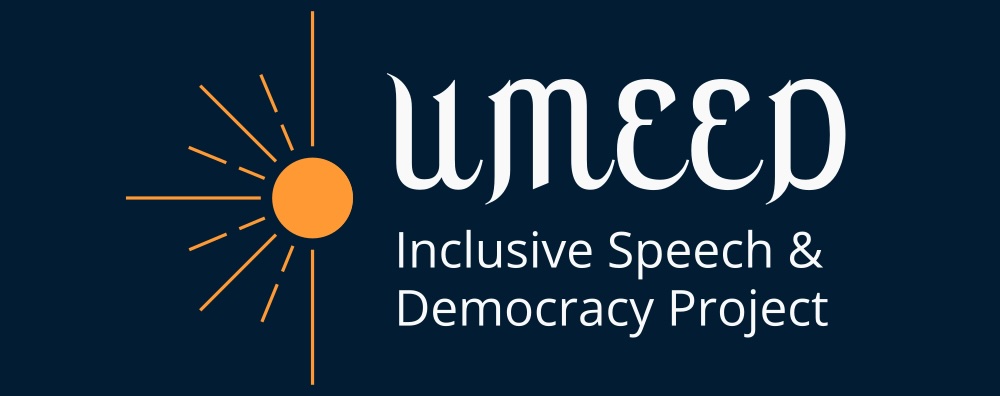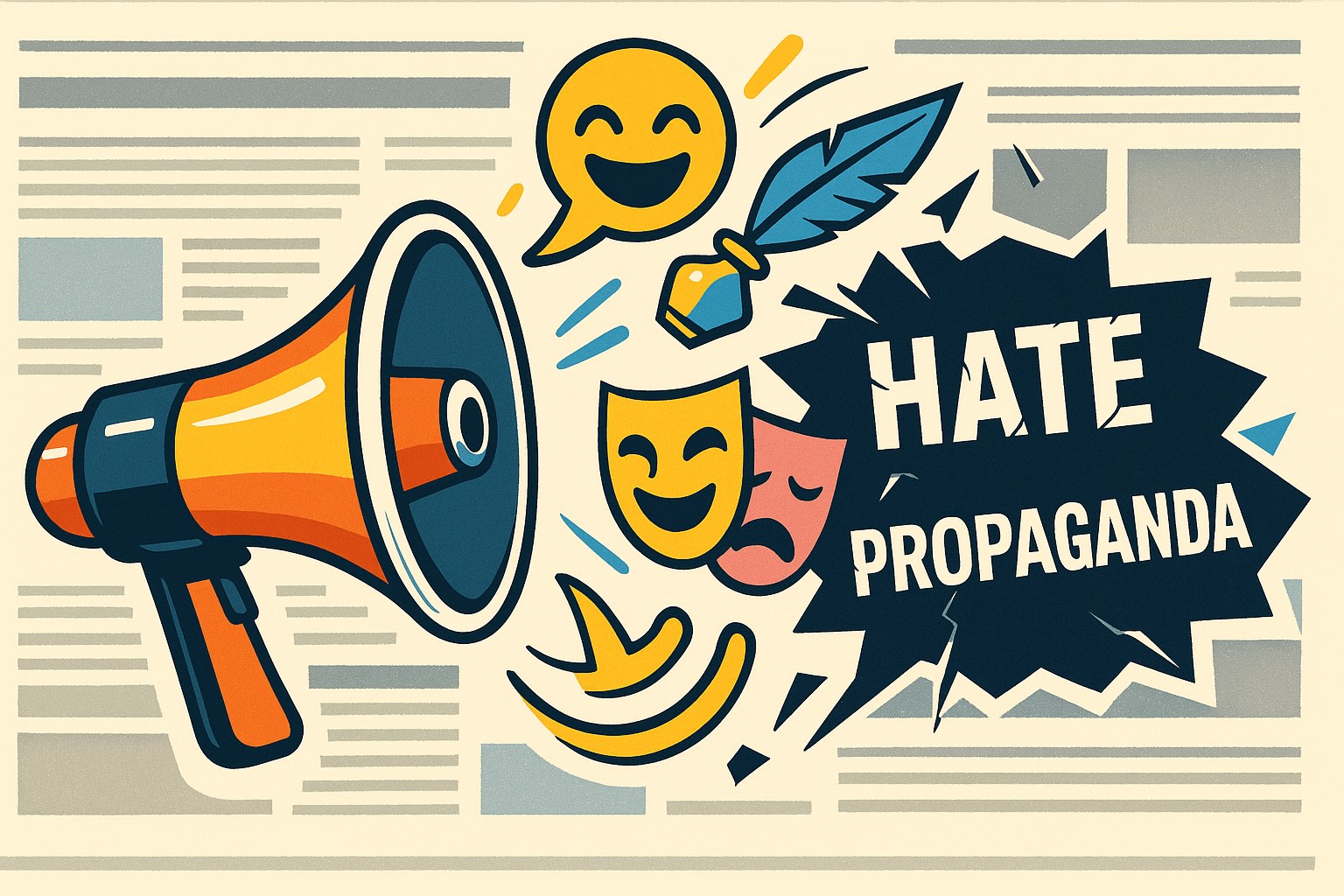The Savala Vada dubs itself “India’s Most Honest News Source”—a satirical Instagram page run anonymously. Its name fuses savala (Malayalam for onion) with vada, the iconic South Indian snack. Through striking graphics and razor-sharp captions, the page skewers political rhetoric, exposes mainstream hypocrisy, and harnesses humor to challenge hate speech and disinformation.
We spoke with one of its co-founders to explore their inspiration, approach, and the power of satire as a tool for countering hate and propaganda.
Umeed: What inspired you to start The Savala Vada and use satire as your medium to counter hate and propaganda in India?
The Savala Vada: There was a sort of vacuum—I kept seeing narratives going abroad with no effective counter-narratives reaching their intended audiences. There were some counter-narratives, but they struggled to gain traction. I looked up pages like Kanda, a Marathi Mumbai–based satirical outlet, but they went inactive. Meanwhile, I watched a lot of Western-centric news, John Oliver and the like, and thought, “Why not do India?” I’m comfortable with English as my primary language, and English can reach diverse parts of India.
There’s an accessibility debate, but I decided on English. There’s so much news, so much strife and hate—how do you jolt people out of that constant exposure to brutality, violence, hate speech, and fascism? Satire became the tool: exaggerated truths, irony, humor. India is the perfect context for it, and I’m glad more people are entering this space.
As we lean toward dystopia, the lines between satire and reality blur—things move so fast you can’t tell true from false. What inspired me was this gap: the right wing, the Hindu nationalist movement, has a robust WhatsApp machinery. I’m not sure I’ve dented that behemoth, but when posts go viral and stir outrage, they create controversy. Controversy means two sides—what’s the other side? It’s about challenging assumptions, offering another perspective.
That’s the page’s purpose: to question what we take for granted. News reports what happened; satire engages people who might not otherwise pay attention. News readers read the news, pop-culture followers follow pop culture—how do you reach those who ignore the news? Our job is to bridge that divide, to say, “Here’s an issue that’s funny but actually very dark, and you need to notice it.” That urge—to fill the gap, spark discourse, set the record straight—got the ball rolling.
Umeed: What makes satire so effective?
TSV: Satire isn’t new. Satirical expression has always thrived in India. Historically, satire flourished under authoritarianism: in the Roman Empire, only the court jester could safely mock the king, and street dramas subverted power by exposing its absurdities. Satire works because it paraphrases what people are thinking and lays bare its folly. It holds up a mirror to society, exaggerates facts, and uses irony to reveal truths that straightforward reporting often cannot.
Take a recent BJP minister’s claim that Priyanka Gandhi was “elected from Kerala because it’s mini Pakistan full of terrorists.” A logical rebuttal is, “Kerala is part of India—how dare you?” Our satirical response embraced “mini Pakistan” completely, creating a tongue-in-cheek tourist guide to mini Pakistan: Kerala’s beaches, the Sabarimala pilgrimage, the oldest mosque, the oldest temple, the oldest church, and a 98 percent literacy rate. By amplifying opponents’ falsehoods to absurdity, we leave them with nothing left to counter and expose their narrative’s emptiness.
In a context where censorship can make even factual reporting risky, satire lets us “report falsehoods” instead—because the government is already peddling lies. We take those fabrications, exaggerate them further, and subvert them. When freedom of expression is curtailed, the most potent response is to state exactly what the power structure demands…and then go one step beyond. That subversive twist is what makes satire extraordinarily powerful in India today.
Umeed: What led you to choose English as the primary language for your Instagram content, and how do you balance its broad reach with the need to engage non–English-speaking audiences?
TSV: Absolutely. English is the language we’re most comfortable with, so it’s the one we use. If we had equal capability in other languages, we’d use them too. But English is the most inclusive “linked” language—while Hindi reaches many, it excludes large swaths of the Northeast, South India, and the diaspora. In fact, if you count second- and third-language speakers, India has the world’s second-largest English-speaking population.
We design our captions so the first slide features big, bold, simple text. Anyone with a basic grasp of English can digest it, and from there people often translate or share in regional languages.
We operate in a digital ecosystem—Instagram—where English predominates. If we were running a newspaper, regional languages would be essential. Online, though, English lets us reach a broader base. We’ve seen our posts shared by people from Kashmir to the Maldives to New York’s diaspora—all in the same language. That’s rare and powerful.
Umeed: How important is it for your content strategy to reach the Indian diaspora?
TSV: Our Instagram analytics show that India accounts for only about 80% of our audience; the remaining 20% comes from the US, UK, UAE, and other communities. Since we’re from Kerala, we know there’s a large diaspora in the Gulf, too.
Second, diaspora communities often seek a connection to their homeland, and many find it in right-wing nationalism. You’ll see people abroad, earning dollars, becoming complacent, and even working to build a “Hindu Rashtra” at home.
The emergence of genuine counter-narratives is a recent phenomenon, but it’s doing great work, especially around issues like caste in the US. Online, and with greater financial flexibility, western-based individuals can devote time to this cause as a side project, whereas many in India are simply too busy to engage at the same level.
You now have networks of young “activists” in Western institutions—from college Hindu collectives to groups at Oxford—who normalize Hindutva under the guise of Indian nationalism abroad. For example, a progressive friend of mine moved to a Western institution and was automatically added to its “Hindu” society, only to find it was pro-state and pro-Hindutva.
Our page counters that by posting in English to reach both Indians and the diaspora, showing them that an alternative narrative exists. Comedians like Abby Govindan repost our stories and say how much it helps them understand local issues, because information access is challenging when you’re abroad. Online ecosystems make that access possible, and that’s why our work is so crucial.
Umeed: Moving on to approach and strategy, how do you decide which issues or incidents to focus on? What makes a particular piece of news, hate speech, or propaganda a good candidate for satire?
TSV: There’s no rigid method, but we stay up to date with current events and pick elements that the average voter needs to know and that impact their lives. If an issue doesn’t directly affect them, we show how it still influences their world and make those connections clear.
We cover large-scale issues alongside smaller stories, such as the “blinkered ambulance” scandal or incremental GST [Goods and Services Tax] hikes on popcorn. Though minute on the surface, these examples link to broader systems of oppression. Satire lets us frame these complex topics through pop-culture references and relatable experiences, breaking the news into bite-sized, accessible pieces.
We don’t preselect topics so much as follow our intuition: Is this relevant? Does it merit discussion? If yes, we satirize it. For instance, when India launched its third nuclear submarine, we riffed: “The world’s 14th hungriest country launches a ₹14,000 crore submarine.” We only rearranged a few words and highlighted societal ironies, yet it prompted people to ask, “Why can’t we talk about it like that?”
So, it’s a blend of intuition, relevance, and deep familiarity with issues that resonate, those people need to know if we want society to head in a better direction.
Umeed: Do social media platforms play a critical role in promoting satire? With today’s global reach, we can share content everywhere—but which platforms work best? Are the most effective ones those where hate speech is rampant (so you can subvert it), or those with largely well-meaning audiences? In your experience, which medium gives your satire the greatest impact?
TSV: Social media has been transformative for accessibility. We started with just thirty followers, and through persistent posting and engagement, our reach has grown phenomenally. But this power is concentrated in a few platforms—and that creates vulnerabilities. For example, our joint video with The Juice Media was taken down on YouTube after a government notice, even though it remains viewable on Instagram. On Instagram, story views can cap around 1,000, and we constantly worry that the platform could remove us—our website backup isn’t even live yet.
As for which platform to target, we chose Instagram deliberately. While Twitter and WhatsApp carry the bulk of hate speech in India, Instagram hits a middle ground: it’s widely used here (unlike TikTok, which is banned), yet it isn’t as text-heavy as Twitter. India’s youth gravitate toward audio-visual content, and Instagram’s format meets that preference. Its virality is “controlled” as stories disappear after 24 hours, encouraging shares without permanent clutter—and its moderation tools let us delete comments, block users, and filter hate speech.
That blend of broad reach, engaging format, and creator control makes Instagram the most effective medium we’ve found for sharing satire and countering harmful narratives.
Umeed: How do you know if your work is making an impact?
TSV: That’s a great question. In truth, we can’t measure impact in a single metric. Instead, we look for signs in the small moments: DMs and comments from people saying, “You’ve helped me unlearn so much,” or “I shared your post in my family’s WhatsApp group and it sparked a debate.” Those individual reactions, whether it’s a conversation about Karwa Chauth traditions or a challenge to ingrained beliefs, tell us we’re doing something right, even if it feels modest compared to the scale of the problem.
Beyond personal messages, our page’s growth, now over 83,000 followers despite occasional shadow bans, shows there’s an audience hungry for a counter-narrative. People engage, share, and discuss issues they’d never questioned before.
None of it is a silver-bullet solution, and there’s still a long way to go. But each comment, share, and new follower represents a small victory and proof that alternative perspectives can gain traction. That momentum gives us hope and signals that others might pick up the torch with their own tools and experiences.
Umeed: Have you seen examples where your satire has sparked constructive conversations or shifted people’s attitudes?
TSV: Our page tends to grow during moments of national moral crisis, one major spike was around the Ram Mandir inauguration last January. We also see engagement around gender and queer issues: male followers often interact when we satirize regressive practices. Satire isn’t polite. It lays bare uncomfortable truths, and yes, we’ve been called insensitive or too dark. But the world is dark, it deserves that unflinching mirror. We’ve seen comments thanking us for challenging norms, DMs saying people have changed their perspectives, and ongoing discussions where none existed before. It may be a small impact, but it’s an impact nonetheless.

